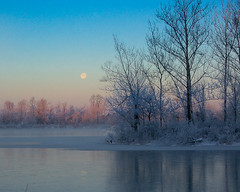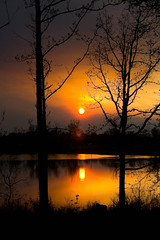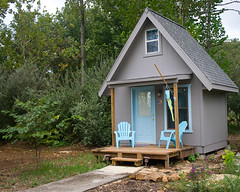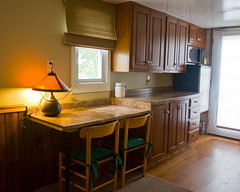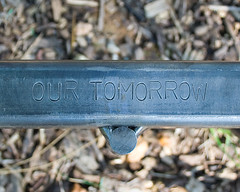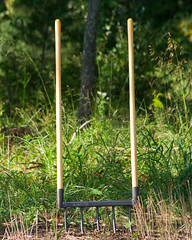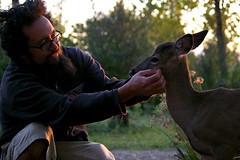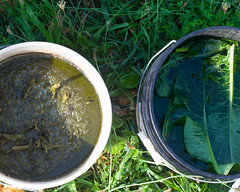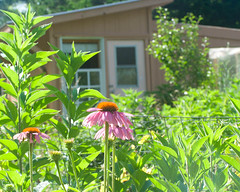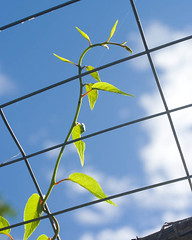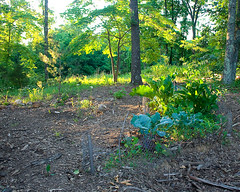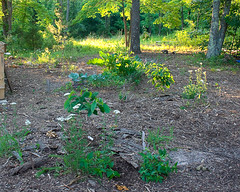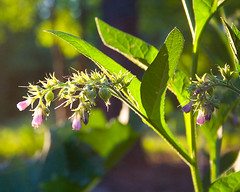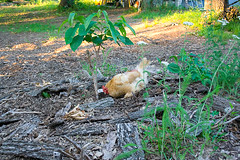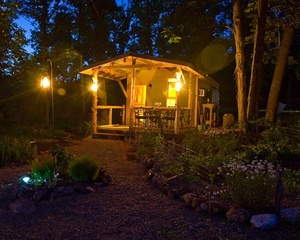The Quiet of Winter
I love every season. Winter no less than the others. The quiet only makes the song of birds more amazing. The lake has frozen with the below normal temperatures of December and the ice makes these haunting sounds as it cracks as a part of the freezing process. I don't really know the mechanics of it but the sound is really amazing and even though I expect it the cracks and strange echos often take me by surprise.
It's been two months since my last post!! I've spent most of that time doing the usual fall/winter chores. Winterizing the waterline behind my cabin was the top priority and beyond that it is the usual of chopping wood, keeping the wood stove going and keeping an eye on the chickens. We've already dipped into the single digits and had about a whole week below freezing. Last December was pretty cold too but I think not quite as prolonged. I think I prefer the extreme cold of winter to the extreme heat of summer. At least in the winter I can put on as many layers as needed and I'm plenty toasty. In the summer one can only be so naked.
Another thing to love about winter is soup and I make it constantly once the cold sets in. Mostly variations of vegetable soup and pumpkin coconut curry. Not only is it hot and tasty but you can't make a cheaper meal.
We never got the door on the greenhouse and while the improvised door put on when we built it does a fine job of mostly keeping out the wind and cold, it does nothing to keep out mice. It fits pretty well but does have some entry points for mice and so my winter greens, mostly kale, have largely gone towards keeping those furry little shits well nourished. Really need to figure out a way to deal with them. Yes, yes I know traps would work but honestly, I think there are quite a few in and around the chicken coop, I'm not sure traps would really do the job. Maybe that is the only way. It goes without saying that I don't use poison... (wait I just said so I guess it doesn't go without saying). Funny, I never really thought about mice as an issue with a greenhouse until I had one.
The girls have finally started laying more eggs. For a couple months I was getting no eggs, or very few. While I think it is fairly rare in the U.S. I'm convinced they had a virus called egg drop syndrome as they had numerous symptoms that matched such as weak shells, bumpy, rough shells, and sometimes no shell at all, just a membrane. Some have told me maybe it was the combination of the extreme heat of summer and molting but I don't think that totally explains at and the shell irregularities point to something else. At this point not only are they laying again but their shells are much thicker and pretty much back to their normal color and texture.
Potentially sad news regarding Petunia the deer... I've not seen her in almost a month. Now, she might be fine but she's never been absent this long before. I'm hoping she was not shot during deer season and it may be that she really is fine, I don't know. She might well have mated with a buck this year and perhaps that might change her behavior? I know that there is a little cluster of deer that she seemed to be hanging out with so maybe she's just with them. Still, I would not think that she would just completely stop visiting me after being so consistent for the past 16 months.
Okie Dokely, I think that's it for the moment. Hope you all are doing well.
Getting stuff done: Hugelkultur beds and greenhouse bed
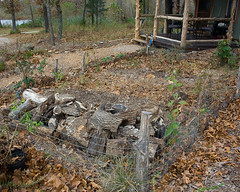 With questions about my residency I'd put a few projects on hold but now that it's all cleared up I've gotten back to work.
With questions about my residency I'd put a few projects on hold but now that it's all cleared up I've gotten back to work.
I doubt it is possible to mouse-proof a greenhouse but I did my best. Last year they ate up my greens, this year hopefully it won't be so easy for them. I put some semi-composted chicken bedding into the soil and got some kale, lettuce, spinach and chard planted. We'll see what happens. I've also stapled up the remaining bubble wrap on the inside ceiling for an added layer of insulation. Last, I've got the north side wall that is shared with the chicken coop stacked up with an internal straw bale wall. I'll also put bales on the east side. I noticed last year that while the water filled black barrels never froze up they also never gained any noticeable heat. Yeah, they were thermal mass but not warm. What I did notice though was that the straw bales that were in there warmed up really well. I figure it can't hurt and will likely help a great deal. I'll share data as the winter progresses. I'll keep one barrel inside filled for watering the plants.
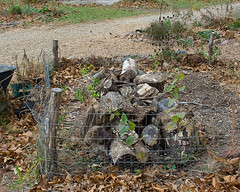 Next on the list, start the Hugelkultur beds in the little keyhole beds outside my cabin. For those that don't know, Hugelkultur is a form of raised garden bed using wood. This is especially important for me because the soil in this garden is contaminated with lead. Years ago this area was heavily mined and in fact the whole area is called the lead belt. The history of these towns is all based on the mining. Years later folk that probably shoud have known better but apparently didn't started using the tailings piles for roads, driveways and anywhere gravel, rock, or sand might be used. They used it around the lake on the roads and back in the 1970s and 80s they used it all around this place for the camp sites. Not smart. I could have them come in and take out the soil but frankly it is a huge mess and I don't necessarily trust the "soil" they bring in to replace the bad stuff. There's certainly nothing fertile about it as it is the brightest red clay you'll ever see. So, my intent is to build keep these beds raised high above the ground level, contaminated soil. I'll just rebuild them every couple of years until I've gotten several feet up.
Next on the list, start the Hugelkultur beds in the little keyhole beds outside my cabin. For those that don't know, Hugelkultur is a form of raised garden bed using wood. This is especially important for me because the soil in this garden is contaminated with lead. Years ago this area was heavily mined and in fact the whole area is called the lead belt. The history of these towns is all based on the mining. Years later folk that probably shoud have known better but apparently didn't started using the tailings piles for roads, driveways and anywhere gravel, rock, or sand might be used. They used it around the lake on the roads and back in the 1970s and 80s they used it all around this place for the camp sites. Not smart. I could have them come in and take out the soil but frankly it is a huge mess and I don't necessarily trust the "soil" they bring in to replace the bad stuff. There's certainly nothing fertile about it as it is the brightest red clay you'll ever see. So, my intent is to build keep these beds raised high above the ground level, contaminated soil. I'll just rebuild them every couple of years until I've gotten several feet up.
Hugelkulter is not hard to explain but I found this excellent post that does the job well:
Hugelkultur: Using Woody Waste in Composting:
Hugelkultur is an ancient form of sheet composting developed in Eastern Europe. It uses woody wastes such as fallen logs and pruned branches in order to build soil fertility and improve drainage and moisture retention.
If you walk through a natural woodland, you will see many fallen logs and branches on the ground. The older these logs are, the more life they sustain. A log that has rested on the forest floor for five or ten years will be covered in moss, mushrooms, wildflowers and even young trees. Poke at it a little and you will notice that the decaying wood is damp in all but the most vicious of droughts.
Hugelkultur is designed to take advantage of the natural fertility and moisture-conserving qualities of rotting wood, while speeding the process of decomposition up. The heat produced by decomposition also helps protect cold-sensitive plants.
In the photos above you can see I've got the semi-rotted wood hauled in and ready to be covered with straw, chicken manure, the last several scoops of wood chips we have. That wood is stacked up about 20 inches. I've got some good soil from our old wood pile (where this wood came from) and will just wheel barrel it down and add for the top layer. It's great stuff full of the rotted bark of lots of logs and is not contaminated. The final beds should be 24 inches above ground level. I'll post photos of the beds when they are completed. These will absorb water all winter and in early spring will be like water filled sponges. The decaying wood will rob the soil of nitrogen so I'll have to fertilize these beds heavily with chicken manure but I think it will be good and is certainly better than digging and growing in contaminated soil.
Land Update
It's been a crazy roller coaster this past two weeks. Since my last update we went back and forth several times first thinking we had it worked out to then not and back and forth again. I didn't want to post until things seemed to settle into something solid enough to report. While there is no final resolution I feel pretty good at where we are at with things. Basically we are back to square one with much better communication and understanding. The land has been taken off the market and if it goes back on it will be up to each of the three siblings to keep or sell their own third and when it happens it will be offered to siblings/family first. If this pans out as it looks my dads share is safely within the family for many years so our work is now, in theory, protected. I don't want to say much at the moment but yeah, we're good. I have a feeling I'll be here for a long time to come. The side benefit is that after the past two weeks of thinking I was going to lose the place I now have a new appreciation for what I had come to take for granted.
Thanks to you all for following along and for your thoughtful, kind comments in the last post. Your words offered a great deal of comfort and encouragement and I greatly appreciate it.
Sad, Sad, Sad
Well, I've got some sad news to report. For me personally, actually, it is far beyond sad. Though it is not decided yet it is looking like our land is to be sold off which will mean the end of my little homestead project. My dad will be meeting with my uncle and aunt on Saturday. Of the three my uncle has no interest in keeping the place and is ready to sell immediately. My aunt, I think, does not really know. My dad wants to keep it since I live here and his children and grandchildren spend alot of time here. I really don't know which way it will go but fear the worst. I don't have a clue as to what I'll do if it sells. I know that for certain I would leave immediately because I have no interest in staying any longer than I have to if it is to be sold. In my heart, if that is the case, I won't be able to bear looking at the trees, bushes, lake or anything else that is here. I knew one day the issue of ownership would need to be resolved but never thought it would come so soon or that there was such a strong tendency towards selling it rather than keeping it.
If it sells I'll have a share of the money but it goes without saying that it is nothing compared to the land and the lake and is certainly not enough to buy anything close to resembling the place. My siblings will be here later today and we'll be talking about the future. Not sure if they will want to pool resources to find another, much smaller bit of land or if I'll be on my own. I think if I'm on my own I'll be looking to find an established eco-village to live. I hate to leave the area and this little town that I've grown so fond of but I don't see myself renting a place in town, don't know that I'd want to buy a place in town either. Feeling kind of lost at the moment.
A Little Village
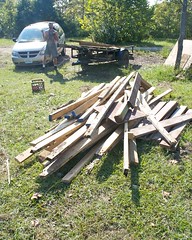 Yet another building is almost finished. Our well house, shower, guest cabin in process. We began by "harvesting" a couple of trailer loads of 2x4, 2x6, and plywood lumber from an old shack behind the dam. We've now salvaged enough from that old structure to build three buildings and have exhausted all the material that was useable. The idea was to rebuild our well house which was very small and not at all easy to do maintenance work in. It needed some work anyway. Rather than just repair it we decided to build something a bit bigger in which we could also put a shower and have some room for storing paint and other items that need to stay warm in the winter. I don't have much room in my cabin to store that stuff and last year kept in a sectioned off part of the chicken coop which is not an ideal place for it.
Yet another building is almost finished. Our well house, shower, guest cabin in process. We began by "harvesting" a couple of trailer loads of 2x4, 2x6, and plywood lumber from an old shack behind the dam. We've now salvaged enough from that old structure to build three buildings and have exhausted all the material that was useable. The idea was to rebuild our well house which was very small and not at all easy to do maintenance work in. It needed some work anyway. Rather than just repair it we decided to build something a bit bigger in which we could also put a shower and have some room for storing paint and other items that need to stay warm in the winter. I don't have much room in my cabin to store that stuff and last year kept in a sectioned off part of the chicken coop which is not an ideal place for it. 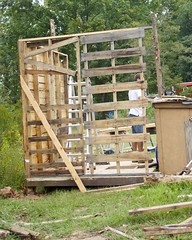 Once we started building it we got to thinking that we had enough salvaged lumber to add on a short second story for extra sleeping space. The only added cost would be the plywood for the loft floor and the exterior siding. We had the old kids' playhouse which was originally built from shipping crates and pallets so that wood has now been repurposed twice! We cut them down to size and put them up.
Once we started building it we got to thinking that we had enough salvaged lumber to add on a short second story for extra sleeping space. The only added cost would be the plywood for the loft floor and the exterior siding. We had the old kids' playhouse which was originally built from shipping crates and pallets so that wood has now been repurposed twice! We cut them down to size and put them up. 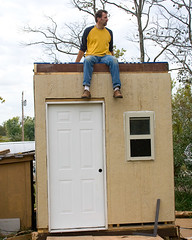 The top floor is now mostly enclosed with roof on, will sleep 3-4 folks though at 5.5 feet it is not a standard height and requires a bit of stooping. With my nephew at 14 he may be wanting to bring down friends then there is my brother and his hunting buddies and I get the occasional visitor so having some extra sleeping space would be good.
The top floor is now mostly enclosed with roof on, will sleep 3-4 folks though at 5.5 feet it is not a standard height and requires a bit of stooping. With my nephew at 14 he may be wanting to bring down friends then there is my brother and his hunting buddies and I get the occasional visitor so having some extra sleeping space would be good. 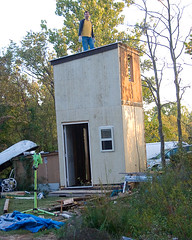 We purchased the siding and metal roof, all other lumber was salvaged as was the insulation. And yes, my brother in law Greg did come down off the roof eventually. I love the crazy shape of this thing... kinda feels like a tree house or a watch tower. We'll probably be putting a deck/walkway on the west and south facing sides. The view from this top floor is really nice. Not only the lake but the garden and other structures we've put up. It is really starting to feel like a little village.
We purchased the siding and metal roof, all other lumber was salvaged as was the insulation. And yes, my brother in law Greg did come down off the roof eventually. I love the crazy shape of this thing... kinda feels like a tree house or a watch tower. We'll probably be putting a deck/walkway on the west and south facing sides. The view from this top floor is really nice. Not only the lake but the garden and other structures we've put up. It is really starting to feel like a little village.
Conservation and Land Ethic
A great article on the Sand Prairie Conservation Area in Missouri, The Vasculum: Strolling the Remnants: Sand Prairie Conservation Area included this quote from Aldo Leopold's A Sand County Almanac in one of the comments. It's been awhile since I read it but I will again very soon:
‘All ethics so far evolved rest upon a single premise: that the individual is a member of a community of interdependent parts. His instincts prompt him to compete for his place in that community, but his ethics prompt him also to co-operate (perhaps in order that there may be a place to compete for). The land ethic simply enlarges the boundaries of the community to include soils, waters, plants, and animals, or collectively: the land. This sounds simple: do we not already sing our love for and obligation to the land of the free and the home of the brave? Yes, but just what and whom do we love? Certainly not the soil, which we are sending helter-skelter downriver. Certainly not the waters, which we assume have no function except to turn turbines, float barges, and carry off sewage. Certainly not the plants, of which we exterminate whole communities without batting an eye. Certainly not the animals, of which we have already extirpated many of the largest and most beautiful species. A land ethic of course cannot prevent the alteration, management, and use of these ‘resources,’ but it does affirm their right to continued existence, and, at least in spots, their continued existence in a natural state. In short, a land ethic changes the role of Homo sapiens from conqueror of the land-community to plain member and citizen of it. It implies respect for his fellow-members, and also respect for the community as such.’
Thanks to Bill for the link.
Early Fall
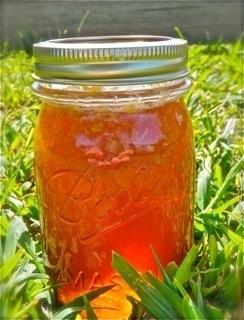
I've really been enjoying the sustained cool weather of late summer. I'm trying to get caught up on my winter firewood. I should get it chopped in spring and early summer so it dry out all summer but coming off of winter I'm usually chopping wood daily for the next day and getting the spring garden going so I once the weather warms I've had my fill of chopping and put it off. Right now it's not a big problem as much of the wood I have has been down for a few years and seems to dry pretty darn fast once I've chopped it up and gotten it covered. In the next couple days I should be able to get enough wood done to last me through December. If the weather is good over the next week or two I should be able to get enough done to get me through January or February. I actually don't mind chopping in the winter as it is the only exercise I get and it warms me up on a cold day... as the saying goes, wood warms you up twice.
Aside from the wood I'm slowly working through the jungle of weeds that the summer garden became when I gave up on it. Putting them as a big layer of mulch out around the blueberries so they'll compost into the soil. There is no doubt the soil around here has been greatly improved over the past two years. So much looser and full of earthworms and nutrients... yes, I'm very happy with the soil! Really, that's what I love the most is the soil. I enjoy gardening but I love enriching the soil and digging my hands into it. I'll probably cover the garden this fall with lots of cardboard and straw which I did not do last fall or spring, hence all the weeds. As I said recently I don't plan to plant the garden next year. I'll just let it sit and rest. The real problem is it is way too big for one person.
Next big outside project is to get any rotten wood hauled up into the small garden to start the Huegelkultur process. Next year I'll focus on a smaller area and see what I can produce. I think I'll be alot happier. Other than that we've got to get the new well house built and I've got to get my new waterline winterized. Oh, yeah, I've got water straight from the well now! I don't think I mentioned that before. So nice to turn on the faucet and have cold, drinkable water! That luxury will make living here in the winter so much easier!
Bees and chickens, chickens and bees. I don't know if I want to keep the bees. I hate to give up on a project but I just don't know that I want to keep them and am leaning towards selling them. I spent a good bit of time this past fall and spring keeping them well fed with sugar water. I did everything (almost) by the book and had such an amazing healthy hive back in March only to have it split twice and end up with a fairly small hive that hasn't produced much in the way of honey. We got one good, full frame which gave us two pints of beautiful, sweet honey. The remaining frames are only partially pulled out and capped. Not counting the equipment investment, I probably spent $15 in sugar... those are two very expensive pints of honey! You could argue that the cost of the boxes, if spread out over 10 years is a good investment but the sugar water is something that has to be fed ongoing. On the one hand I do love certain aspects of bee keeping but I'm not sure it is enough to keep them. It's a project that only gets bigger and more time consuming as the hives grow and split and grow and split.
The chickens have been another frustration this summer. The egg harvest went way, way down and really I was/am confused about what the exact cause was. Part of the problem was my own doing I think. Somehow I missed the lesson about the importance of calcium in their diet. I knew they needed it and had been feeding them their ground up egg shells. I did not realize just how important it was though and didn't know that I should probably also be feeding them oyster shells. I did notice their shells were not real strong and then a funny thing started happening. Egg production started to decline back in June and I also started noticing eggs with just a membrane or in some cases no shell at all. They would just sort of lay a blob of egg. This was happening at the same time that black snakes moved in and started stealing eggs. I think I captured at least 8 in July and August. But because of the snakes I didn't realize that they were starting to lay fewer eggs. Add to this mix the fact that I caught the hens themselves eating a few eggs and I've got at least three or four variables/explanations. As of the past two or three weeks I've been lucky to get 2-3 eggs a day from 11 hens.
While I do adore my girls I don't keep them as pets and I want to be able to sell enough eggs that they at least pay for their feed. I've been feeding them oyster shells for a month and am hoping that helps with the soft shell and reduced egg laying. In a way it may be a good thing that they are taking a break from laying because I'm seeing that they are getting their feathers back. Now that I've got their diet fully rounded with the calcium source I'm hoping that perhaps we'll go into the fall with fully feathered, rested hens that have a more balanced diet. I feel terrible that my ignorance contributed to them not being as healthy as they should be.
All in all it was a difficult summer but we've made real progress. A covered porch, running water, renovated interior in the red cabin, lots of new perennial garden beds and no major losses. Kerry and Greg and the kids will be able to spend alot more time down here thanks to the red cabin remodel so that is good news. In theory the work done this summer should make for more frequent and more comfortable visits for my folks as well since they stay in the red cabin too. The next big project is a porch for the red cabin which we should be able to knock out in a couple weekends next spring. There's a good bit of perennial landscaping I'd like to do around the cabins next spring but nothing too crazy. Next year should provide lots more time for enjoyment and less time with construction.
The Gulland Forge Broadfork!
The UPS guy showed up a little bit ago to deliver my new, hand-made broadfork gifted to me by Larry Cooper. He makes them by hand and let me tell you, what an awesome tool. The ash handles had a really nice smell thanks to the linseed oil/turpentine finish and I pushed them into the metal fork assembly. It was then that I noticed the engraving "Our Tomorrow" which, honestly, brought a tear to my eye. Just when I thought such a gift could not possibly get any better there is that thoughtful detail. Larry: THANK YOU.
I've not had a chance to use it much yet as I was eager to post this. But I DID use it a bit and wowza, this is one fantastic tool. It just works, like an extension of the body. I stepped on to the center of it and my weight pushed it into the earth and then I just gave it a gentle rock back to loosen the soil. I can't wait to work some beds with this! Everything about it from the handles to the tines just feels so solid. America needs to return to this kind of hand-made quality.
Will post more when I've had a real chance to give the broadfork a real workout!
Gulland and his Broadfork Blog
After yesterday's post I got a comment from Gulland offering to send me a gardening tool that he makes. He didn't mention what it was so I went looking at his blog and found that it is called the broadfork. I've heard of this tool but never used one. From what I read it is used to replace the tiller and is kinda like a very wide pitchfork to loosen/till the soil. I don't generally till as I prefer disturbing the soil as little as possible leaving the soil community intact but I do use a sorta modified double dig method on my beds when I first set them up which lossens the soil 1-2 feet down resulting in a raised bed of loose soil 2-3 feet in depth. It seems this is the perfect tool for that as well as for loosening the soil every couple of years. Not only does it not use oil but I'd guess that it is a much more gentle process in terms of disrupting the layers of the soil. I think it aerates the soil without turning the layers, thus adding oxygen and improving the soil structure without destroying the soil community. That it is human powered is very important given our current climate, peak oil situation. Here's Gulland's blog post reply to a gardener named Tom and I thought I'd post it here as it addresses the issue perfectly:
Tom told me that he never even cranked his rototiller this year; he did it all with the broadfork he got last year. He also said that he would never have to use the rototiller in any of those beds again.
That's heavy stuff to me; I have created a business that provides an implement that allows people to step back from the use of fossil fuels to do the 'heavy lifting' in their gardens. Because of my broadfork, there is one less rototiller running in California this year!
Tom, I have to say that your email and photos have made me know that I am doing the right thing. Thank you for turning the lights on for me.
I am an Alabama native, and lived my first 42 years there. The Gulf of Mexico was in my backyard, and I loved visiting that coast.
The point of this blog was to inform people about the utility of the broadfork and give some insight into the man that makes them. I never wanted to be political, or controversial. I must say, however, that the disaster that has occurred with the deep water drilling platform in the Gulf of Mexico has made me feel that any time I can steer someone away from the use of fossil fuels to good old fashioned hand labor, I have done a good thing. The reason you are reading this is that you believe the same thing that I do.
We need to lessen our need to use petroleum products. The low hanging fruit has all been picked, and the rest of the crude oil that is available is in the inhospitable places where it is probably best to just leave it alone.
When I've had a chance to try it out I'll be sure to post a review. If only I'd had a tool like this over the past decade or two I might have fewer back problems!! A big thanks to Gulland for getting in touch and for his generous offer.
Opps, edit. I did some more reading and wow. Gulland is not only building a great tool but the way he does it is a fantastic example of building the local economy. In these times of rising unemployment and a job market dominated by meaningless jobs at Wal-Mart and McDonalds, Gulland is creating a useful tool from scratch! Read more in this post on his blog.
Finally, some cool
What a summer it has been. Hot, hot, hot. I just adore climate change. Yes, yes, I know we cannot attribute the heat of any one particular summer to climate change but I mean, really. Records have been broken all over the planet. You can believe what you want, for me, I’ll attribute it to climate change. But really, this post was not to be about that.
Hi. How’s it going? I’ve not posted in a month. I’ve struggled a bit this summer, much more than the first two summers here at the homestead. Not sure if it has been the heat or just my attitude but I’ve just not been able to be my normal fairly happy, content and appreciative self. Who knows? The human mind is a strange thing, I do know that.
But tonight and these past few nights (and days) of the first real cool wave in awhile, I’m happy and will enjoy it and try to extend it. Got the grass cut today and started chopping the winter wood from the aging pile. In theory it would be best to get it chopped, stacked and covered in the spring. In reality by spring I’m tired of chopping wood all winter and have so much spring time garden work to do I don’t do the chopping. I found last year that the wood I have is old enough that If I can get it chopped and drying by mid September it will dry out pretty well by my first fires, usually in November. It is mostly wood that has been down now for 3-5 years and so it dries out pretty fast. I’ll have to get that pile burned this year if it is to be burned because some of it has started to rot and by next winter will be too far gone.
Which brings me to my next subject. Huegelkultur. Yeah, hows that for a word?? Yeah, yeah, take that. Huegelkultur is apparently something that has been used in parts of Europe for a long time and really, sounds great. Basically, you take tree logs and stumps and bury them with soil, straw, wood chips or whatever you have on hand. The idea is that these are raised beds for gardening and can be anywhere from a foot to several feet high. The benefit is that the logs absorb winter and spring rainfall and then hold that into the summer keeping the beds moist. They also, of course, slowly decompose thus as long term compost will increase the soil structure and fertility of the beds. The downside is that they will tend to rob nitrogen from the soil but I’ll make up for that with lots of chicken poop and pee.
I’ve determined that next year’s garden is going to be MUCH smaller. In fact, I may do nothing at all in the old garden and will likely focus my food production on the area around my cabin, say 100 feet out in any direction, zone 1 in permie terms. The big kitchen garden I’ll likely cover with straw and cardboard and just let it be for the forseeable future. I probably will plant some flowers in there and may even work on making it a flower/herb garden for the next two years. Then perhaps when the hornworms have lost the scent and when I’ve got gobs of established strong smelling herbs and bright flowers I’ll try slipping in a few tomatoes and other veg. But really, for my personal food I think I’ll have much greater success and a much happier summer if I just focus on a smaller area and do it well.
Most everything in the way of berry bushes and fruit trees survived the hot dry summer. We’ve got a few apple trees that are overcome with cedar rust and need to come out. I’ve no interest in fighting that every year and would rather just put in those that are resistant. We lost one plum this spring and one peach tree that came back from the ground after dying up top. Looks pretty good actually. The kiwi vines are looking fantastic and growing very well. The potted eggplant produced but have struggled with the heat. Next year I’ll pot them up again but will transplant when they reach a foot high. The flea beetles that seem to devastate them the first year seem to have been much less of a problem this year due to the pots and/or the location over here by the cabin.
Biggest lesson learned this year is the garden is too big and way too much work when it is hot and dry. Yup. More to come, hopefully in an update before another month has passed. I’ve got a bit of news about projects I’ve been working on in town.
Me and Petunia
Petunia is a year and two months old now. This picture was taken last fall. What an amazing animal and experience it has been to raise her and watch her grow. She still comes around almost once a day for a visit and I enjoy every second of it. There's nothing quite like a deer that lets you love on her and returns the favor. If I stay outside long enough she'll lay down after eating and she always faces the lake, it is as though she is watching the sunset. So beautiful.
Darn it
Apprently I had comment moderation turned on and did not realize it till today! I think I must have turned it on sometime last summer though I don’t remember doing it. Anyway, got lots of comments posted that I would have responded to. Most notably the comments to my post about killing the dogs last fall. It was not something I’ll ever be at peace with and I don’t know if I could do it again… I’ll never forget that day. Just read through the comments and posted a short response. Most folks seemed to understand but one was very angry to say the least. In any case, I’m going to turn comment moderation off as soon as I post this.
Growing and eating local food
It is raining here this morning which is something we really need. As I recall we had about a quarter inch of rain in June and May was fairly dry too. Not only that but daily temps in June averaged 4-5 degrees above normal, above 90 most days in June. Very hot, very dry and not an easy month for gardeners! So far we’ve had just over an inch in the past two days, maybe 1.25 and that’s not enough. We could easily do with another 5-7 inches, preferably spread over a week or so! My rain barrels have filled a bit but have a long way to go and the swale has yet to show any signs of filling. Looks like we’ll get a good bit today and then they say a good chance of rain much of next week with temps at or below 90 so that is welcome news. Lesson learned this summer? Heavy mulch will only do so much to retain moisture. No doubt it is a huge help but things DO eventually dry out!!
So, the garden looks pretty ragged. The potatoes and tomatoes in particular. One bed of tomatoes look okay but the other two have struggled. I planted onions and lettuce in those beds in early spring with the intention of having a nice living mulch and it did not work out so well. Back in late March/ early April not long Ifter I got my lettuce, spinach, carrots and other cool weather crops planted we had a pretty nasty hot spell and weeds started popping up everywhere. The end result was that the beds of annual green veggies I envisioned were heavily mixed with LOTS of weeds and not nearly thick enough to really serve as a mulch for the tomatoes which got planted in later. The tomatoes which I mulched with newspaper and straw is, by far, the best of the tree beds. Next year I’ll go back to the paper/straw mulch and just plant the outer edges with basil and flowers.
I got my squash in a bit late and that was another mistake. With the exception of a couple lost most survived the heat and are growing but they are not thriving. The watermelon volunteer that sprouted up early is doing great and has taught me that next year I REALLY need to get my squash/melons started earlier. In fact, really, I think I need to get EVERYTHING started about a month earlier. All that said, I do have better potatoes than last year and a nice bed of carrots and I had a great harvest of sugar snap peas. The blackberries that I left out in the food forest by the chicken forage have done great this year and I’m really glad I left them when I set up that area. I’ve been harvesting many big handfuls everyday. I probably could have set some aside for preserving but have just been eating them up! Further out from the cabin I know the blackberries are producing gobs of fruit so I really should go out and gather some.
Last would be the food forests and they are doing pretty well considering the drought. Blueberries, currants, gooseberries and pawpaws are doing great. I’ve got gobs of comfrey I need to get put in the ground and am going to give the last few rhubarb plants to Karen. I think I’ve got 12 rhubarb plants in the ground now. Yeah, that’s a crazy amount of rhubarb but it is a beautiful plant and fairly easy to grow. I’ll give or sell what I can’t eat! I’ve planted it with Comfrey around the greenhouse and in the food forest behind my cabin.
One last thing, not about the homestead but about the local farmers market: fantastic! I went last night and came home with a bag of sweet corn gifted by Karen and David (THANKS!!) as well as a loaf of Donna’s yummy home made bread. Also a very nice cucumber and some peaches. Dinner was a cucumber tomato sandwich, two of those actually and 4 cobs of sweet corn. I don’t cook the corn or add anything at all, just peel and eat!! I’m surprised more people don’t eat it that way. It doesn’t need to be cooked and is so sweet and juicy. Yeah, the corn was desert. Oh, oh and a big glass of iced Kombucha too thanks to Juli. It took 10 days but the fermenting tea is now a perfectly fizzy and tasty treat. The perfect meal to eat while enjoying the soft patter of rain on the roof.
Homestead Life and Death
It's been a couple weeks since I posted a homestead update. I've had my first chicken deaths by predator. Just over a week ago I lost two of my girls, I think to a fox. Whatever it was came out just before dark before I'd put the girls in for the night. I've since been very cautious. Putting them up earlier and making more frequent trips outside to make my presence known during the day. I've also been playing music during the day in the hopes that it might be a bit of deterrent. Towards evening when the original incident happened I've made it a point to be out doing a project in the garden or near the coop. With this hot, sticky weather I'm always more likely to be working in the evening anyway.
I've also discovered why I was seeing a decline in egg laying: the girls are laying as usual but a big black snake had taken up residence deep in the straw bedding of their coop. I shoed him out once but he's back. I'm going to try to catch him in a pillowcase and relocate him. It took a full year before I had a black snake messing with the coop so I'm hopeful that if I can relocate him perhaps I'll have another year without another.
My comfrey has really taken off this year and I'm getting a good harvest which is going into five gallon buckets for brewing into a potent comfrey tea. After 7-10 days the leaves have transformed into a stinky green slurry full of nutrients. This can be applied as a foliar spray or watered into the roots. I've also got a bucked of chicken manure tea that will be watered down and used after a couple of weeks, probably on the comfrey and tomatoes.
The garden is coming along with everything planted at this point. The peas finally gave up but I got a good crop out of them. After a slow start I've gotten gobs of lettuce though it is now starting to bolt. The carrot and onion crop is looking really good. The squash and watermelon are looking great and have blooms. I was a bit late getting my pumpkin seed in but better late than never! I've potted the eggplant up and have them closer to the cabin. Last year the eggplant plated in the garden was decimated by flea beatles so I'm hoping to control that by potting them and keeping them closer. So far so good. The perennial borders are starting to fill up with coneflowers and feverfew with the gaps filled in by annuals such as zinnias. The tomatoes are coming along and the basil seedlings are starting to take off.
I've gotten my first harvest of rhubarb and will get a good bit more this year. The rhubarb seedlings started this year are doing fantastic but I won't harvest them till next year. I've still got more rhubarb to get into the ground as well as 18 comfrey plants. I may end up selling some of the comfrey at the farmers market. Last but not least, the Hardy Kiwi is growing very well and has, in this second year, already reached the top of the garden entry arbor. I have little doubt it will completely cover the arbor by the end of July given the current rate of growth. It is a beautiful vine!
It's been a very hot June with temps way above normal. I'd really love some rain and a cool-off!!
The Economics of the BP Gulf Disaster
The last three or so paragraphs in the quote below are really fantastic. Really.
The Automatic Earth: June 10 2010: BP, Forrest Gump, Mr. Bean and the White House:
Matt Simmons knows oil. His 'Twilight in the Desert' is one of the best books on the topic, highly recommended. Simmons also knows finance; he’s, after all, an oil banker. And he insists that both the Gulf spill is in fact much worse than BP and the White House are willing to admit, and that BP's liability commitments will bankrupt it within weeks. While there will always be the notion that Simmons says what he does in order to turn a profit, I personally lend quite a bit of weight to what he's been saying since the spill started. Simmons is one of the few voices left in the drama worth listening to.
BP has now officially, as I've said was likely to happen, seamlessly moved from 'just' an environmental disaster into an economic calamity as well. Don’t underestimate the impact of this. BP is the planet's fourth largest enterprise. For one thing, this means the company has vast political influence, especially in the US and UK.
...
That should put you right in line with what will be playing out now. BP's bankruptcy looks like a foregone conclusion. That is, unless the US and UK governments step in, and do so broadly and very loudly. With both money and legal changes. The former, because BP faces far more in lawsuits and damage claims than it has in liquidity (its shares are now worth less than its assets, always an alarming sign). The latter, well, for more or less the same reason.
One party you don’t want to be when BP's bankruptcy lands square squash on the table is a Louisiana fisherman or a Florida tourist operator. British pensioners first! Sure, Obama has declared that BP is liable for all damages yada yada, but there’s a long list as we speak of Gulf Coast residents who can’t hardly squeeze a penny out of the company even now, and that’s before any serious litigation has started.
It’s all just posturing. By the time the real claims arrive, BP will likely be very deeply mired in interminable Chapter 11 and/or subsequent proceedings, and the little man will be dead broke and waiting for years to see if he may ever get a single penny for what he worked long and hard to build up, whether he’s Forrest Gump in Terrebonne Parish or Mr. Bean in Coventry.
And don’t kid yourselves, it’s not about BP, one single oil company, and it’s not about Obama or Cameron, about single politicians. With perhaps slight differences, Shell and Exxon perform within the same dismal agenda's BP does, and there's no politician left in our Western hemishpere who rises to true power and has not been pre-empted by the system he or she voluntarily chooses to function in, and who doesn't voluntarily participate in perpetuating the hologram their voters long for in order to continue their feeling of comfort, so they can sit in their oversized homes and watch pictures of dying birds on oversized plasma TV's.
And please don’t be too eager to proclaim you're different, or better than that. That’s nothing but the easy way out.
Remember, you’re not watching real life with real people, you’re watching a 24/7 theater play that has no other reason to be than to provide you with what it knows beforehand you will respond positively to. Remember that, and then look at the dying pelicans. You may be running out of chances to make it right. Is that the way you want your life to be?
Some Climate Change Facts
Irregular Times has a great post regarding the climate data from the NASA Goddard Institute. For those that like to pick one winter and pretend that it voids reality because it snowed and was cold, well, they're wrong. Frankly it is pathetic that so many are so cowardly that they will do anything to continue living a life of convenience rather than step up and deal with this crisis. Yes, it is cowardly.
The Goddard temperature data speak:
By Month
5 Coolest Januaries on record: 1893, 1887, 1885, 1909, 1895
5 Warmest Januaries on record: 2007, 2002, 2010, 2005, 2003
5 Coolest Februaries on record: 1893, 1887, 1905, 1891, 1917
5 Warmest Februaries on record: 1998, 2010, 2002, 1995, 2004
5 Coolest Marches on record: 1911, 1917, 1888, 1898, 1908
5 Warmest Marches on record: 2002, 2010, 2005, 2008, 1990
5 Coolest Aprils on record: 1911, 1907, 1909, 1918, 1892
5 Warmest Aprils on record: 2010, 2007, 2005, 2002, 1998
5 Coolest Mays on record: 1917, 1890, 1907, 1918, 1909
5 Warmest Mays on record: 1998, 2007, 2009, 2002, 2005
5 Coolest Junes on record: 1913, 1907, 1903, 1894, 1885
5 Warmest Junes on record: 1998, 2009, 2005, 2006, 2007
5 Coolest Julys on record: 1912, 1907, 1909, 1904, 1890
5 Warmest Julys on record: 1998, 2009, 2002, 2005, 2008
5 Coolest Augusts on record: 1912, 1907, 1903, 1918, 1890
5 Warmest Augusts on record: 1998, 2003, 2006, 2005, 2009
5 Coolest Septembers on record: 1912, 1903, 1890, 1904, 1964
5 Warmest Septembers on record: 2005, 2009, 2003, 2006, 2008
5 Coolest Octobers on record: 1912, 1887, 1903, 1917, 1882
5 Warmest Octobers on record: 2005, 2003, 2009, 2006, 2004
5 Coolest Novembers on record: 1890, 1919, 1892, 1907, 1910
5 Warmest Novembers on record: 2009, 2001, 2004, 2005, 2006
5 Coolest Decembers on record: 1917, 1916, 1882, 1910, 1892
5 Warmest Decembers on record: 2006, 2003, 2005, 2009, 1997
By Season(temperatures still measured globally; season labels refer to Northern Hemisphere seasons)
5 Coolest Winters on record: 1892-1893, 1917-1918, 1916-1917, 1910-1911, 1886-1887
5 Warmest Winters on record: 2006-2007, 2009-2010, 2001-2002, 2003-2004, 1997-1998
5 Coolest Springs on record: 1917, 1911, 1909, 1918, 1890
5 Warmest Springs on record: 2002, 2005, 2007, 1998, 2008
5 Coolest Summers on record: 1907, 1912, 1903, 1890, 1904
5 Warmest Summers on record: 1998, 2009, 2005, 2007, 2006
5 Coolest Autumns on record: 1912, 1903, 1809, 1884, 1910
5 Warmest Autumns on record: 2005, 2009, 2003, 2006, 2004
By Year
5 Coolest Years on record: 1917, 1907, 1890, 1887, 1909
5 Warmest Years on record: 2005, 2007, 2009, 2002, 1998
(Source: NASA Goddard Global Land-Ocean Temperature Index, accessed May 16 2010. The pattern in land-only temperature datavaries only slightly from the land and ocean data, bearing out the same general pattern.)
Geek Gardening: A Wired Guide to Domestic Terraforming
I was browsing through my RSS feeds this morning and come across this fantastic article in Wired which is basically about permaculture though they don't use that word. Instead they discuss gardening as a process of careful design described as terraforming... essentially, permaculture. Excellent color design diagrams ranging from small gardens on apartment terrace or big garden spaces in a suburban or rural setting. If you are the least bit interested in taking gardening to the next level this is really worth a look, a great introduction and a nice surprise that it came from WIRED!
Making my claim in the gulf
I've not written about the oil spill here yet. But like many people it has been on my mind much of each day. Anyone that knows me will tell you how I feel about cars, lawn mowers and other machines that require oil to run. I truly detest them. My life here on the permaculture homestead is all about trying to use less energy, less oil. Even so I can't help but feel the deepest regret and guilt when I see the images of oil covered birds struggling to lift their heads or to take a breath or blink their eyes. Eve though I try very hard not to drive without necessity the truth is I still drive a car. I purchase food grown with oil and other fossil fuels. I purchase other synthetic items derived from oil. I am a part of this. One of those oil covered birds is my bird. I claim it. I own it. That is what I see with each picture and the question I ask with each one is that my bird? It is breaking my heart over and over and over.
Swale and Food Forest Update
Last year I put in a swale and food forest on the north and east sides of my cabin. I planted the swale with comfrey, rhubarb, juneberry and yarrow with space between for annual veggies. This spring I seeded it with radish, chard, broccoli, kohlrabi, and cabbage. I'm pretty happy with the results thus far. The comfrey and rhubarb have filled it nicely and the veggies are going great in the swale. Now, if only we'd get some rain. Been a pretty dry spring. In the past 6 weeks we've had maybe one really good rain fall. The five rain barrels have come in very handy though they are nearly empty!
The pawpaws and juneberries are doing great. Well, Petunia has nibbled the juneberries so they're not great but would be were it not for her. She's left the pawpaws alone and they are growing very well. The herbs growing around the pawpaws, a mix of yarrow, self-heal, oregano, lemon balm and coneflowers are also growing pretty well. I've got some strawberries I'm about to put in though I'll have to put some chicken wire over them to protect from deer and chicken. I'd put them in the main garden originally and they were doing fantastic but Petunia got to them and ate ALL of the foliage. Soon after they were taken over by weeds.
One key difference between the food forest and the kitchen garden is that the food forest seems much less prone to weeds. I think the reason is that, while in a sunny pocket, this area has mostly been wooded and the mix of foliage here is much less aggressive. The kitchen garden by contrast is located in an area that has been an open field for the past couple of decades or more. Any bare spot of soil up there quickly sprouts up with "weeds". I'm thinking the strawberries will do much better over here. The key will be keeping them protected with the chicken wire.
One other key to this food forest area is the combination of light and heavy mulch. This pocket of woodland gets full sun most of the day with just a bit of dappled shade. That combined with the heavy wood chip mulch and leaf litter has really helped with the water retention. I've also got lots of big bark chunks from chopping wood that I place around the little trees. It helps discourage the chickens from scratching to close to the trees and holds in the moisture. The fertility of the soil is also being improved greatly I think. At the moment the chickens are back in the fenced forage area but they've been free ranging for the past ten months or so and have stirred and pooped in the food forest mulch that whole time. Next on my to-do list in this area is to add in more low level herbs to begin filling it out.
Lots going on...
In the past couple of weeks we’ve had lots of progress with a variety of projects. The cabin finally, really feels complete. The porch is my favorite place to be which is what I fully expected. I added a new flower bed and have put in rock creek paths to replace the composted mulch which was raked into the flower beds. The garden beds in the area immediately around the cabin (Zone 1 in permaculture terms) are shaping up pretty good. Lots of lettuce, chard, kale, kohlrabi, cabbage and radishes as well as perennials such as rhubarb and comfrey. The flowers too are starting to take hold with blooms. The last touch was moving the little garden pond from it’s somewhat neglected location to a spot just a few feet away from my porch. Frankly this little corner of the world is starting to resemble a moment or scene in a storybook which is what I’d hoped for.
Other projects that have been tidied up or finished include the new fire ring which also got a thick layer of rock creek gravel. The kids cabin is fully painted and trimmed with the last bit of deck finished. In the main garden the crop of onions, garlic, and peas are fantastic. The potatoes are looking great. Two beds of tomatoes planted and looking good with another bed to go in soon. Still to do, transplant or sell my remaining rhubarb, tomato, and comfrey seedlings. I also need to get the basil planted as well as melons and pumpkin.
The chickens have been spending their days in the lush chicken pasture that I prepared this spring and they seem to be pretty happy with it. I miss having them free range and do intend to let them range for a couple evenings a week but they will be spending most of their time in the pasture as long as it is holding up. I won’t let it get run down to the same point as last year. While it was sometimes somewhat problematic I really miss having them in close proximity to the cabin.
It’s gonna be getting hot and humid soon so I’m going to go crank out a few loads of laundry. Have a good day!
